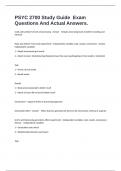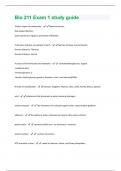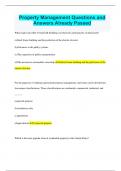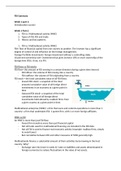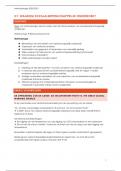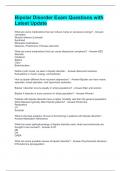1
Environmental Psychology Articles Summary
2020-2021
blue = lecture notes
WEEK 1 - LECTURE 1: Setting the Scene
The social function of physical environments.
Article 1: Wohlwill (1970) - The Emerging Discipline of Environmental Psychology
-> Theoretical paper about the role of environmental psychology, with a phylosofical touch
Main Issues:
Environmental psychology is a response to concerns about quality of the environment (why
Environmental Psychology is important). He says that environmental psychology is a
response to the concerns about the quality of the environment. We should limit the growth
of our popoulaiton for the environment’s sake.
Environmental psychology is problem-oriented, applied, inclined to cooperate in
multidisciplinary projects. -> need to work with a multidisciplinary team to really try to solve
the problem together & view the problem from different points of view.
Environmental psychology has unique potential to ask new questions -> environment as a
common good, can ask questions about what people do for the common good? What does
nature do with this? What is the effect of crowding, dense cities on humans and the
environment?
Man-environment relations:
Three forms of relationship between person and physical environment:
1) Environment guides and constrains behavior: barriers, compatibility, fit, environment is
instrumental -> If you want to relax in your home and your home is dense and tiny then the
environment does not fit with the need to feel relaxed. So people may go outside to the street
to find some relaxation or go running in the park. So environment can create a barrier but also a
fit to guide you.
2) Long term exposure to general conditions may exert generalized effects: urban lifestyle as a
function of crowding, working day rhythm as function of climate -> if you live in a dense
environment that is very crowded, then you have less trust. Leaving in a constant feeling of
crowdedness and density makes people feel less trusting – so has a generalized effect. If you
leave in one climate e.g. in Spain where it is warm, people uptake a different life – work in the
morning then take a siesta and work again,
3) Behavior is oriented toward environment; environment is focal (pro-environmental behavior?)
Environment and affect:
The environment as a source of affect
1) Affect evoked by stimulus characteristics; complexity, diversity, novelty, category -> Different
characteristics of the environment can evoke different emotions. Important characterisitcs
of the environment can be that it is complex, diverse, novel and these can lead to different
emotions.
2) Environment determines approach and avoidance reactions; moving, migrating, holiday
destinations (whether you want to approach or avoid an environment)
, 2
3) Adaptation (people need an optimum level of stimulation, of complexity, but after a while it
loses its novelty, thus neutralizing stimulation that previously was effective). -> People seek
for the optimal level of sitmulation, if people are not stimulated they get bored. On the other
hand people get used to the stimulation and they get bored again. So they seek for
more/different/ new stimulation. The environment can help here, eg. Climing a hill.
Adaptation (“man is at once a seeker and neutralizer of stimulation”)
a) Along which dimensions?
b) At what costs? (residue)
c) Adaptation or adjustment?
i) Do you change the physical environment?
Psychological or physical solutions Is it stressful to be bored? Answer seems to
be yes.
Issues not elaborated-Not mentioned in depth but important:
- Symbolic and cultural transformation of environmental effects → cultural transformation of
for instance noise, an airplane passing by (interpersonal societal and cultural influences).
- Individual differences in for example sensation seeking, environmental concern are highly
individual traits (sensation-seeking scales & other similar instruments), interpersonal
differences in terms of environmental dispositions, etc.
- Attitude formation and attitude change regarding environmental problems (pollution,
congestions, depletion of natural resources, etc.)– if you want to influence people’s
sustainable behavior attitude change is important.
- Problems that seem environmental but are primarily social, economic, educational, political
(slums, ghettos) - Some problems seem to be environmentally related but are actually
caused by other aspects.
● Paradox: There is a focus on the environmentally determined basis of behavior on the one
hand, but absence of the role of the physical environment in behavior on the other.
(psychologists were not specific about the meaning of environmental influences, they were
more general e.g. influence of attending nursery school to socialization, etc.).
0 In psychology there is little interest for the physical environment that serves as a
background and context for behavior. The role of the “environment” has almost
invariably referred to social or interpersonal influences, or else to effects presumed
to be ascribable to the milieu in an altogether unspecified sense.
一 But, behavior is functionally related to characteristics and attributes of the physical
environment.
● There are 3 forms of the interrelationship between behavior and environment (same as
Man-environment relations)
0 (1) behavior necessarily occurs in some particular environmental context, which
imposes major constraints on the range of behaviors permissible in it, and
frequently serves to determine in a more positive sense particular aspects or
patterns of an individual’s behavior.
■ Behavior, and particularly movement, occurs within a given type of space;
the use made of environmental spaces, and the manner in which the spatial
environment may itself be constructed or modified to accord with an
individual’s preferences, values, etc., becomes itself an important subject for
study.
, 3
■ Ecological approach to the study of behavior → Barker & Wright.
■ The use of space in everyday behavior → proxemics → the perception of
space and spatial relations among objects and persons; habits, attitudes, and
values concerning the use of space and interpersonal distance; behavioral
consequences of architectural design, etc.
● Proxemics is the study of human use of space and the effects that population density has on
behaviour, communication, and social interaction.
■ Mental maps formed by individuals of their geographical environment.
○ (2) certain qualities of the environment, such as under- or overstimulation,
crowding, severity of climate, etc., may exert generalized effects on broader systems
of response within the individual (thus → influences of environmental variables on
general attributes of behavior and personality).
○ (3) behavior is in a variety of ways instigated by and directed at particular attributes
and characteristics of the physical environment. Behavior is influenced and directed
by the characteristics of the physical environment. The environmental characteristics
will influence whether an individual will approach or avoid an environmental
situation.
■ Humans develop diverse forms of adjustment and adaptation to
environmental conditions.
■ And exhibit temporary and permanent responses of approach to and
avoidance of / escape from given environmental situations (tourism,
migration, recreation).
● Three more facets of this interrelationship: ENVIRONMENT & AFFECT
(1) Affective and attitudinal responses to present environmental attributes
Environment as a source of affect and attitudes
● Physical environments have the power to elicit affect. The bases for
these affective reactions are based on the principles of arousal and
motivation. For arousal & motivation, the stimuli should have
certain attributes e.g. complexity, incongruity, novelty, variety, etc.
o Human interest and amount of voluntary exploratory
activity increases monotonically with stimulus complexity
and affective & evaluative responses reach an optimal value at
low or intermediate level of complexity (so human affective
behavior and attitudes are related with environmental
attributes)
● Specific vs. diverse exploration (Berlyne), two modes of exploratory activity:
o One directed at information seeking
o The other at affective arousal
- Practical implication: positive function of ambiguity and uncertainty in the layout
of building and urban areas
, 4
(2) Approach and avoidance responses to environments potentially or actually available to the
individual
Approach and avoidance responses determined by environmental attributes
The physical environment does not only arouse strong affective reactions but also is an
object of approach and avoidance behavior
→ Raises questions about demography, ecology, environmental management.
● Linked to Migration patterns (in-migration (country to city) vs. out-migration.
o Difficult to disentangle the influence of physical environment from
economic and sociological factors in explaining patterns of
migration/residential choice.
● Adaptation to given environmental conditions, and phenomena of selective
perception and image formation.
● Temporary movement through the environment (vacationing, tourism).
→short-term environmental search & exploration movements may be important for the
individual’s adaptation to and tolerance of his permanent environmental circumstances
(E.g. if living in a crowded area, a vacation to a remote area will help you tolerate that),
social &economic life and ecology of the visiting area.
(3) Adaptation to environmental qualities as a function of prolonged exposure
Man is at once seeker & a neutralizer of stimulation -> able to adapt behaviorally and
biologically to the most varied and extreme environmental conditions but, his affective
and attitudinal responses similarly change as a result of prolonged exposure to any given
environment (in the direction of neutralizing this excitement). Adaptation level
theory. = Seeker: humans need an optimal level of stimulation, so they seek for novel,
complex environments. But, humans are able to adapt behaviorally and biologically even
to the most extreme environments. This also costs changes in their attitudes and
emotional responses towards the environment, mostly towards the direction of
neutralizing their excitement. So they adapt.
o In order for humans to tolerate this adaptation (resolve this
continual strain), the environment can provide approach and
avoidance reactions e.g. they can go for vacations in a less crowded
area.
The mover-stayer problem (Wolpert)
o Based on an individual’s tolerance of the environmental conditions
and what actions he takes to resolve this continual strain. It is the
experience and resolution of a conflict situation: adapting or
adjusting to the environmental condition -> adaptation &
adjustment = alternate models of handling discomfort and stress
deriving from the environment
o We get used to environmental circumstances by adapting and
frequently arrive at more active modes of adjustment to them,
which have the effect of reducing the strain placed on our
adaptation processes themselves.
Also we use artificial adjustments → does our reliance on artificial
adjustments for instance AC reduce our tolerance for extreme heat in the
long run?
Environmental Psychology Articles Summary
2020-2021
blue = lecture notes
WEEK 1 - LECTURE 1: Setting the Scene
The social function of physical environments.
Article 1: Wohlwill (1970) - The Emerging Discipline of Environmental Psychology
-> Theoretical paper about the role of environmental psychology, with a phylosofical touch
Main Issues:
Environmental psychology is a response to concerns about quality of the environment (why
Environmental Psychology is important). He says that environmental psychology is a
response to the concerns about the quality of the environment. We should limit the growth
of our popoulaiton for the environment’s sake.
Environmental psychology is problem-oriented, applied, inclined to cooperate in
multidisciplinary projects. -> need to work with a multidisciplinary team to really try to solve
the problem together & view the problem from different points of view.
Environmental psychology has unique potential to ask new questions -> environment as a
common good, can ask questions about what people do for the common good? What does
nature do with this? What is the effect of crowding, dense cities on humans and the
environment?
Man-environment relations:
Three forms of relationship between person and physical environment:
1) Environment guides and constrains behavior: barriers, compatibility, fit, environment is
instrumental -> If you want to relax in your home and your home is dense and tiny then the
environment does not fit with the need to feel relaxed. So people may go outside to the street
to find some relaxation or go running in the park. So environment can create a barrier but also a
fit to guide you.
2) Long term exposure to general conditions may exert generalized effects: urban lifestyle as a
function of crowding, working day rhythm as function of climate -> if you live in a dense
environment that is very crowded, then you have less trust. Leaving in a constant feeling of
crowdedness and density makes people feel less trusting – so has a generalized effect. If you
leave in one climate e.g. in Spain where it is warm, people uptake a different life – work in the
morning then take a siesta and work again,
3) Behavior is oriented toward environment; environment is focal (pro-environmental behavior?)
Environment and affect:
The environment as a source of affect
1) Affect evoked by stimulus characteristics; complexity, diversity, novelty, category -> Different
characteristics of the environment can evoke different emotions. Important characterisitcs
of the environment can be that it is complex, diverse, novel and these can lead to different
emotions.
2) Environment determines approach and avoidance reactions; moving, migrating, holiday
destinations (whether you want to approach or avoid an environment)
, 2
3) Adaptation (people need an optimum level of stimulation, of complexity, but after a while it
loses its novelty, thus neutralizing stimulation that previously was effective). -> People seek
for the optimal level of sitmulation, if people are not stimulated they get bored. On the other
hand people get used to the stimulation and they get bored again. So they seek for
more/different/ new stimulation. The environment can help here, eg. Climing a hill.
Adaptation (“man is at once a seeker and neutralizer of stimulation”)
a) Along which dimensions?
b) At what costs? (residue)
c) Adaptation or adjustment?
i) Do you change the physical environment?
Psychological or physical solutions Is it stressful to be bored? Answer seems to
be yes.
Issues not elaborated-Not mentioned in depth but important:
- Symbolic and cultural transformation of environmental effects → cultural transformation of
for instance noise, an airplane passing by (interpersonal societal and cultural influences).
- Individual differences in for example sensation seeking, environmental concern are highly
individual traits (sensation-seeking scales & other similar instruments), interpersonal
differences in terms of environmental dispositions, etc.
- Attitude formation and attitude change regarding environmental problems (pollution,
congestions, depletion of natural resources, etc.)– if you want to influence people’s
sustainable behavior attitude change is important.
- Problems that seem environmental but are primarily social, economic, educational, political
(slums, ghettos) - Some problems seem to be environmentally related but are actually
caused by other aspects.
● Paradox: There is a focus on the environmentally determined basis of behavior on the one
hand, but absence of the role of the physical environment in behavior on the other.
(psychologists were not specific about the meaning of environmental influences, they were
more general e.g. influence of attending nursery school to socialization, etc.).
0 In psychology there is little interest for the physical environment that serves as a
background and context for behavior. The role of the “environment” has almost
invariably referred to social or interpersonal influences, or else to effects presumed
to be ascribable to the milieu in an altogether unspecified sense.
一 But, behavior is functionally related to characteristics and attributes of the physical
environment.
● There are 3 forms of the interrelationship between behavior and environment (same as
Man-environment relations)
0 (1) behavior necessarily occurs in some particular environmental context, which
imposes major constraints on the range of behaviors permissible in it, and
frequently serves to determine in a more positive sense particular aspects or
patterns of an individual’s behavior.
■ Behavior, and particularly movement, occurs within a given type of space;
the use made of environmental spaces, and the manner in which the spatial
environment may itself be constructed or modified to accord with an
individual’s preferences, values, etc., becomes itself an important subject for
study.
, 3
■ Ecological approach to the study of behavior → Barker & Wright.
■ The use of space in everyday behavior → proxemics → the perception of
space and spatial relations among objects and persons; habits, attitudes, and
values concerning the use of space and interpersonal distance; behavioral
consequences of architectural design, etc.
● Proxemics is the study of human use of space and the effects that population density has on
behaviour, communication, and social interaction.
■ Mental maps formed by individuals of their geographical environment.
○ (2) certain qualities of the environment, such as under- or overstimulation,
crowding, severity of climate, etc., may exert generalized effects on broader systems
of response within the individual (thus → influences of environmental variables on
general attributes of behavior and personality).
○ (3) behavior is in a variety of ways instigated by and directed at particular attributes
and characteristics of the physical environment. Behavior is influenced and directed
by the characteristics of the physical environment. The environmental characteristics
will influence whether an individual will approach or avoid an environmental
situation.
■ Humans develop diverse forms of adjustment and adaptation to
environmental conditions.
■ And exhibit temporary and permanent responses of approach to and
avoidance of / escape from given environmental situations (tourism,
migration, recreation).
● Three more facets of this interrelationship: ENVIRONMENT & AFFECT
(1) Affective and attitudinal responses to present environmental attributes
Environment as a source of affect and attitudes
● Physical environments have the power to elicit affect. The bases for
these affective reactions are based on the principles of arousal and
motivation. For arousal & motivation, the stimuli should have
certain attributes e.g. complexity, incongruity, novelty, variety, etc.
o Human interest and amount of voluntary exploratory
activity increases monotonically with stimulus complexity
and affective & evaluative responses reach an optimal value at
low or intermediate level of complexity (so human affective
behavior and attitudes are related with environmental
attributes)
● Specific vs. diverse exploration (Berlyne), two modes of exploratory activity:
o One directed at information seeking
o The other at affective arousal
- Practical implication: positive function of ambiguity and uncertainty in the layout
of building and urban areas
, 4
(2) Approach and avoidance responses to environments potentially or actually available to the
individual
Approach and avoidance responses determined by environmental attributes
The physical environment does not only arouse strong affective reactions but also is an
object of approach and avoidance behavior
→ Raises questions about demography, ecology, environmental management.
● Linked to Migration patterns (in-migration (country to city) vs. out-migration.
o Difficult to disentangle the influence of physical environment from
economic and sociological factors in explaining patterns of
migration/residential choice.
● Adaptation to given environmental conditions, and phenomena of selective
perception and image formation.
● Temporary movement through the environment (vacationing, tourism).
→short-term environmental search & exploration movements may be important for the
individual’s adaptation to and tolerance of his permanent environmental circumstances
(E.g. if living in a crowded area, a vacation to a remote area will help you tolerate that),
social &economic life and ecology of the visiting area.
(3) Adaptation to environmental qualities as a function of prolonged exposure
Man is at once seeker & a neutralizer of stimulation -> able to adapt behaviorally and
biologically to the most varied and extreme environmental conditions but, his affective
and attitudinal responses similarly change as a result of prolonged exposure to any given
environment (in the direction of neutralizing this excitement). Adaptation level
theory. = Seeker: humans need an optimal level of stimulation, so they seek for novel,
complex environments. But, humans are able to adapt behaviorally and biologically even
to the most extreme environments. This also costs changes in their attitudes and
emotional responses towards the environment, mostly towards the direction of
neutralizing their excitement. So they adapt.
o In order for humans to tolerate this adaptation (resolve this
continual strain), the environment can provide approach and
avoidance reactions e.g. they can go for vacations in a less crowded
area.
The mover-stayer problem (Wolpert)
o Based on an individual’s tolerance of the environmental conditions
and what actions he takes to resolve this continual strain. It is the
experience and resolution of a conflict situation: adapting or
adjusting to the environmental condition -> adaptation &
adjustment = alternate models of handling discomfort and stress
deriving from the environment
o We get used to environmental circumstances by adapting and
frequently arrive at more active modes of adjustment to them,
which have the effect of reducing the strain placed on our
adaptation processes themselves.
Also we use artificial adjustments → does our reliance on artificial
adjustments for instance AC reduce our tolerance for extreme heat in the
long run?


